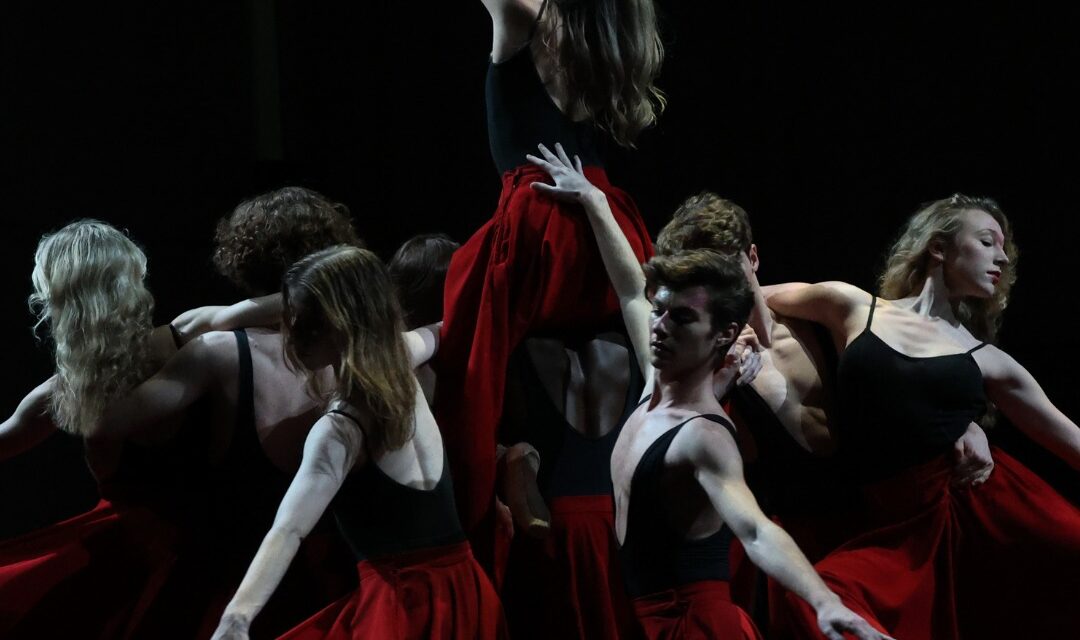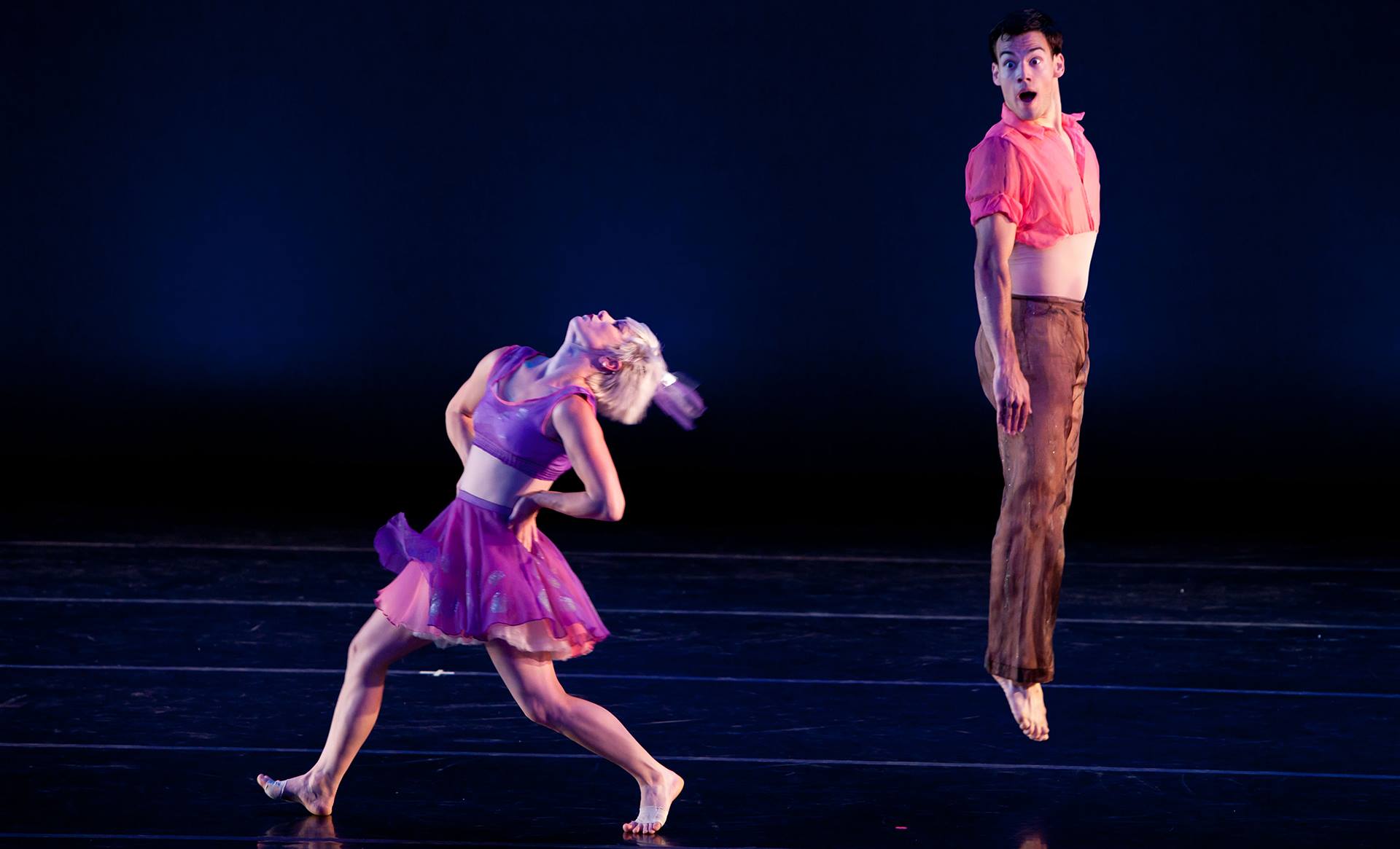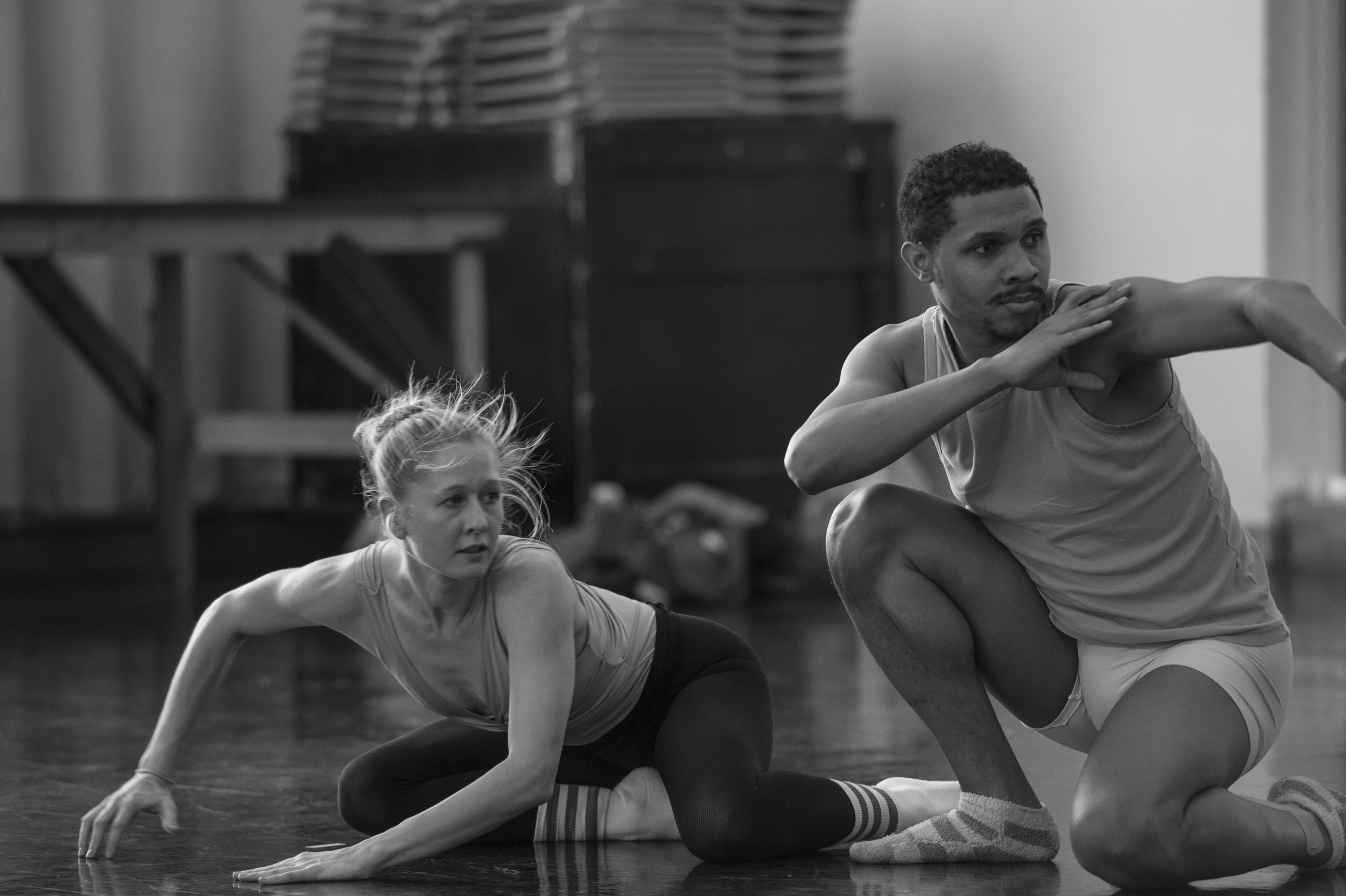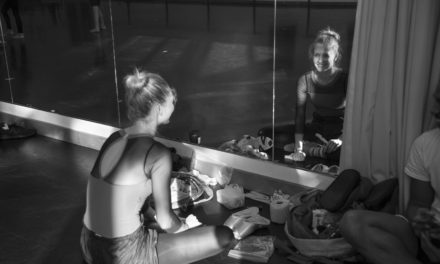Ashley Thursby’s “Variations”. Photo: Kateryna Sellers.
ChorShow 2024
Louisville Ballet
Various choreographers
A review by Amberly M. Simpson
Entire contents are copyright © 2024 by Amberly M. Simpson. All rights reserved.
The Louisville Ballet continued its tradition of creating opportunities for its company artists to choreograph original works with their 2024 production of ChorShow! This mixed repertory performance featured six original works created by their studio and company dancers.
Unlike their previous productions this season, ChorShow was the first to embrace their “Season of the Commonwealth” theme with two of the works having explicit ties to Kentucky culture, and others still being inspired by aspects of Kentucky, though not explicitly about it per se.
The show opened with “Soma” choreographed by Company Artist Daniel Scofield. Set to bluegrass music by Louisville’s own Misty Mountain String Band, this work drew inspiration from Kentucky’s rural roots, including folk dance integrations and movement motifs that harkened back to the physical labor disproportionately borne by rural communities.
One of the strengths of this piece was in the way it wove together and moved moments through space. This not only helped to create a feeling of the passage of time, like we were watching this community on fast forward but also to create contrast between the light and youthful energies of characters like the Children (Amber Wickey and Brad Delaney) against the more mature and serious characters, such as the Mother and Father (Shelby Shenkman and Mark Krieger).
Overall, the piece leaned heavily into a sort of rural nostalgia, presenting what felt like a romantic stereotype of a rural community, absent the balance of real rural life challenges. While the piece had a feel-good warmth to it, there was also a rich opportunity for dipping into the more nuanced existence of these communities that I think would be worth exploring in a future draft.
The second piece in the show, “Woven” by Studio Company Dancer Adrah Cook, was a perfect representation of contemporary dance. This is one piece in particular that shined in the intimate performance space. The thundering of the dancers’ feet landing on the sprung floors in unison helped to create a more visceral experience, as well as to underscore the power of connection discussed in the work itself.
This work featured many small groups of dancers coming together, sharing connections and showing support for one another. Each of these sections tended to end on more pedestrian movement and a more literal show of support (often to transition the dancers offstage) in comparison to the more abstract representations in the meat of the choreography. While I can see the reasoning behind this, I think the abstract movement was both strong enough and clear enough that these departures from the movement vocabulary were not necessary to convey meaning.
The first act concluded with a unique and fascinating narrative work entitled “Thoroughbred” choreographed by Company Artist Minh-Tuan Nguyen. This work definitely stood out against the rest of the works in the show, with a vibe that I can only describe as ballet meets Squid Games. Here, we are dropped into an authoritarian society where people, clad in what looked like pink painters’ bodysuits, competed in relay races while being supervised by Officers and an Idol. If you break the rules, expect to face the wrath of *The Creature*!
This work, as a whole, was incredibly engaging. Nguyen somehow was able to create something that was simultaneously classic (the narrative ballet) and modern (dystopian fiction) all at once. It is certainly worthy of expansion, perhaps into a full one-act ballet. That said, in its current format, it left me with more questions than it did any feelings toward its theme of acting against the grain. The narrative arc spends quite a bit of time in exposition and introducing the character of the Officers, but very little on the actual act of defiance. Yet, the emphasis on exposition also did not provide us with much context. I wanted to know more about this society and who these people were. I wanted to know what they were competing for and why. I wanted to know who this Final Contestant was, and what exactly he was rebelling against. I wanted to know who/what the Creature was, and how it came to be in the hands of the Officers. As an audience member, I was invested in the work, so I certainly hope a more complete and developed version will grace the Louisville Ballet stages in the future!
Act two kicked off with Company Artist Ashley Thursby’s “Variations”, a piece whose journey began in 2015 and went through multiple iterations before emerging in its current format. This was one of the more abstract works in the show, not only in presentation but also in program notes where there was no explicit description of what the piece was about, only a quote from Ralph Waldo Emerson.
“Variations” would ebb and flow between a strict and clear organization of the dancers, to more free-form structures and a sense of (mostly) organized chaos. Throughout this, I enjoyed the way it played with recurring imagery, as well as the constant creating and dissolving of images in a line that trailed through the space.
This piece also featured some of the most non-gendered costuming in the show, with all dancers in a black, form-fitting top, and an ankle-length red skirt, allowing you to focus on the content of the work, as opposed to interpreting meaning and relevance from the perceived gender of the dancers. Choreography aside, it was just a stunning look on everyone.
Studio Company Dancer Caleb Emory’s piece “Come Sit By My Side” was another piece that leaned into the nostalgia of bygone days. I was admittedly skeptical of this work from the onset as someone whose family definitely experienced some of the darker trends of the “golden” era of romance, but I was delighted to see that this was approached with some nuance with the featuring of queer partnerships. That said, the piece was less about the golden era of romance in general as the program implied, and more about one specific couple who happened to come together in that time period.
The narrative of this piece was guided by voiceovers placed between each song, recollecting experiences across the lifespan of two lovers, played by Brienne Wiltsie and Christian Chester. Each of these voiceovers was a poem sourced from Emory’s great-grandfather’s journals, resulting in a work that was both personal and universal. While I appreciated the vulnerability of each poem and the way they helped to set the intention for each section of the choreography, the reading/recordings of the voiceovers themselves could have been stronger, being at times difficult to make out with clarity, and overall emotively flat. The narrative as a whole, however, was a painful reminder of the human condition, and the unavoidable consequences of living and loving.
The show concluded with its second explicitly Kentucky-centric piece: “A Day at the Derby” by Company Artist David Senti. The subject matter of this piece offered a lot of opportunity to lean into the spectacle, but Senti kept the piece very reined in, opting for a conservative fascinator over a flamboyant centerpiece of a hat (both literally for costumes and metaphorically for choreography). It still contained that characteristic Derby excitement of arriving at the track and partaking in races, though, structurally, this piece didn’t feel as much like a closer as I would have expected. The choice to end on a more pulled-back duet when the rest of the piece was high energy felt like a lull, as opposed to the closure it was intended to give. An ellipsis, but not a period. Additionally, I was unsure why the men appeared to be participating in the racing as jockeys when they began the piece attending as gentlemanly spectators alongside the women.
While the bright and colorful nature of the costumes carried that characteristic Derby spirit, the style of the dresses lacked cohesion. One dress read as a nightgown, one as Celtic, two as medieval, and another still as 1920s flapper era. The dresses felt like they were being sourced from across many different costume closets, a stark contrast to the men’s costumes which very distinctly and effectively portrayed both a gentleman’s/spectator’s attire and a jockey-style getup.
As a whole, the Derby is such a rich subject matter for creating a dance work. It is both locally relevant, but also so broadly recognized that it has the potential to be relevant as a work on the world’s stage. In its current representation, Senti’s piece felt a bit under-explored, but I hope that he will continue to invest in this choreography, bringing greater emphasis and spectacle to the tropes and foibles of the actual Derby experience, as it has real potential to grow into something of broader recognition!
Something I appreciated about this show as a whole was that the choreography had been intentionally designed for the space in which it was performed. The Louisville Ballet’s studio space positioned the audience on two opposing sides of the stage, a setup that can very easily turn your performance into a front view and a back view. However, as someone sitting along the “back” wall, it never felt like we were being neglected in our viewing. Indeed, it felt intentionally balanced between the two sides.
Additionally, as a collective, the dancers showed tremendous growth in embracing the intimate audience setting. The performance as a whole displayed greater authenticity from most of the dancers, which was a tremendous boost to the choreography itself.
Historically, ChorShow has been one of the Louisville Ballet’s edgier shows, often touching on themes that are more controversial, and allowing the artists to speak with greater rawness and authenticity than a MainStage show might typically allow. This year’s production was a distinct departure from that tradition with works that were, thematically speaking, incredibly safe, leaving little room for offense, or even opinion. As a whole, the show was pleasant, but underwhelming. Some of the pieces could have been better supported by rearranging the show order to create a more fulfilling journey for audiences. Compositionally, it felt as if there was both a desire and a struggle to abandon traditional ballet expectations in choreography, leading to works that didn’t have the chance to fully actualize. I even wonder if the sudden emphasis on Commonwealth-connected themes may have hindered the overall variety and depth of the work created. In general, I enjoyed myself, but I would have found a greater connection with works that held a bit more social relevance, took creative risks, and/or encouraged me to leave the theatre with new perspectives on the world at large.
ChorShow 2024
January 25 – 28, February 2 – 4 @ 7:00 pm
Louisville Ballet
315 East Main Street
Louisville, Kentucky 40202
Louisvilleballet.org
Amberly M. Simpson is a Choreographer, Dancer, and Dance Educator/Advocate originally from Glendale, California. She specializes in Modern, Post-Modern, and Contemporary Dance forms, creating work that is often interdisciplinary in nature to provide commentary on social issues and the human condition. By day, she is the Dance Director and Musical Theatre Co-Director at Noe Middle School, but by night she serves as the Artistic Director of Ambo Dance Theatre. Amberly’s work has been presented at venues such as the American Dance Festival Movies by Movers, the Going Dutch Festival, the Midwest Regional Alternative Dance Festival, and Princeton Research Day where her collaboration with Dr. David Vartanyan received the Impact Award. In 2019, she was honored as one of the Hadley Creatives through the Community Foundation of Louisville, and in 2022 she worked alongside her Dance colleagues in the Jefferson County Public Schools to launch the first-ever All County Dance program for the state of Kentucky.





